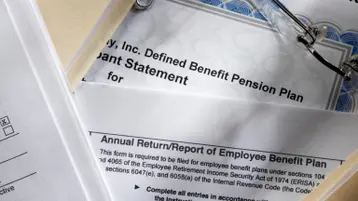
Table of contents
- 1.Benchmark benefits
- 2.Be smart when choosing your healthcare plan
- 3.Rein in your contributions
- 4.Eliminate underutilized benefits
- 5.Enlighten employees about their benefits
- 6.Automate your benefits processes
United States healthcare costs have been rising for decades, and this trend is likely to stay. According to PricewaterhouseCoopers, healthcare spending is forecast to return to pre-pandemic levels in 2022, but an increase of 6.5% in medical costs is also expected. The COVID-19 outbreak, in particular, has elevated the mental health and substance use crises — ultimately increasing demand for mental health services and related healthcare spending. These healthcare cost increases inevitably impact employers that offer group health insurance. For this reason, reducing healthcare costs remains a top priority for employers — even for larger employers that tend to have deep pockets. In a 2021 Kaiser Family Foundation survey, “nearly 90% of large employers surveyed believe the cost of providing health benefits to employees will become unsustainable in the next five-to-10 years, and 85% expect the government will be required to intervene to provide coverage and contain costs.” Meanwhile, employers are basically on their own. It’s important to watch not just your healthcare spending, but other benefits expenditures as well. If you happen to be spending too much on benefits, below are 6 ways to cut back.
In a 2021 Kaiser Family Foundation survey, “nearly 90% of large employers surveyed believe the cost of providing health benefits to employees will become unsustainable in the next five-to-10 years."
1. Benchmark benefits
This will give you a solid grasp of what other employers are paying for employee benefits. You can get a general idea from reports compiled by the U.S. Bureau of Labor Statistics (BLS). However, these BLS reports tend to be broadly applied. To obtain granular information based on your industry and location, you’ll need a customized benchmarking report. Customized benefits benchmarking can deliver insight into employer trends for:
- Healthcare and welfare plans
- Preventative health and wellness plans
- Retirement savings and planning benefits
- Financial and compensation benefits
- Leave benefits
- Family-friendly benefits
- Flexible working benefits
- Employee programs and services
- Professional and career development services
- Housing and relocation benefits
- Business travel benefits
Benchmarking can let you know how many employers offer the above benefits and how many plan to offer them. It can also tell you whether you’re spending too much on benefits and where you might need to scale back. To start, you may review TriNet's Benefits Benchmark Report, which supplies health insurance data on businesses with 1-500 employees.
2. Be smart when choosing your healthcare plan
Health insurance usually accounts for the biggest portion of employee benefits spending, so make sure your choices are financially prudent. Tips for curbing health insurance costs:
- Look for customized solutions that fit your employees’ individual needs. Unless all of your employees have the same needs, steer clear of one-size-fits-all plans. Employees are more likely to use plans that cater to their own needs instead of pre-packaged plans designed for everyone.
- Explore the feasibility of a high deductible health plan (HDHP). The HDHP will reduce the cost of medical premiums for you and your employees — but it will also mean higher deductibles for your employees. HDHPs are most suitable for employees whose healthcare needs are low-maintenance.
- Offer a health savings account (HSA), if you decide to go with a HDHP. The HSA is a tax-advantaged account that helps to offset the cost of the HDHP.
- Provide health insurance through an Internal Revenue Service (IRS) cafeteria plan. These plans come with tax savings for both the employer and employee.
- Verify your cost-sharing amount. Many employers cover around 70%, while employees shoulder about 30%. Make sure you’re not bearing too much of the cost.
- Work with a broker who can help you lower your prescription drug expenses. Spending on prescription drugs is one of the most rapidly growing areas of healthcare expenditure.
- Shop around and compare plan prices. This helps ensure optimum value for your money.
3. Rein in your contributions
While employer contributions, such as 401(k) match, are vital to attracting and retaining talent, you need to be realistic about your contributions. Evaluate all of your employer contributions for voluntary benefits and eradicate any excesses. Regarding 401(k) plans, employers typically match somewhere between 3% and 6% of employees’ wages. However, depending on the type of 401(k) plan, the IRS may require the employer to match up to a specific amount of wages. In this case, do not go below the IRS’ mandated match. If you fall on hard times, such as during an economic slowdown, you may be able to suspend or discontinue your 401(k) match — but this must be done legally and according to the plan document rules.
4. Eliminate underutilized benefits
Keep in mind that you cannot discontinue mandatory benefits, such as paid leave and workers’ compensation required by state law.
Take a microscopic look at all the benefits you provide. Do you see any that are not being utilized enough to justify the cost of providing them? If you have no reason to believe these benefits will start earning their keep, discontinue them. Keep in mind that you cannot discontinue mandatory benefits, such as paid leave and workers’ compensation required by state law. Also, mandatory participation rules may apply to certain voluntary benefits — even though the benefit itself is not mandatory. For example, if you offer a 401(k) plan, you must allow eligible long-term part-time employees to participate in the plan. So, before you discontinue benefits, be sure to assess all requirements.
5. Enlighten employees about their benefits
In a 2021 survey by Voya Financial, 35% of employees say they do not fully understand any of the “benefits they enrolled in during their most recent open enrollment period.” In addition, “Two-thirds (66%) of working Americans want their employer to help them better understand the benefits they enrolled in throughout 2021.” When employees do not understand their benefits, they are more likely to make poor financial decisions regarding those benefits. They may, for example, visit the emergency room for an ailment that could have been more cost effectively treated via telehealth. Or, if they’re unaware of your Employee Assistance Program (EAP), they might delay getting help for mental health issues they may be having — which can ultimately cause severe productivity losses for your business. If you do not have a dedicated HR/benefits team to educate employees about their benefits, consider bringing in a benefits broker or consultant to assist.
6. Automate your benefits processes
Benefits automation is key to efficiently managing your benefits programs and decreasing administrative costs. For example, an automated, integrated benefits system:
- Fully automates your benefits processes
- Facilitates new hire onboarding
- Enables online benefits enrollment
- Integrates timekeeping, scheduling, and payroll
- Eradicates duplicate data entry and reduces human errors
- Streamlines and simplifies open enrollment
- Promotes compliance with employee benefits laws
- Equips employees with a self-service portal to manage their benefits
- Integrates with third party apps, such as accounting and applicant tracking systems
- Lets you create standardized procedures for employee benefits
- Organizes and stores benefits records
- Delivers analytics and reporting to improve benefits decision-making
- Sends benefits enrollment data electronically to benefit carriers
Without an automated system, the above activities would take a dizzying amount of time to complete — due to being paper and labor intensive. Such manual processes invite a host of consequences, including financial losses. If your benefits system is outdated, consider upgrading to a more modern, less costly solution.
This article is for informational purposes only, is not legal, tax or accounting advice, and is not an offer to sell, buy or procure insurance. It may contain links to third-party sites or information for reference only. Inclusion does not imply TriNet’s endorsement of or responsibility for third-party content.

Grace Ferguson
Table of contents
- 1.Benchmark benefits
- 2.Be smart when choosing your healthcare plan
- 3.Rein in your contributions
- 4.Eliminate underutilized benefits
- 5.Enlighten employees about their benefits
- 6.Automate your benefits processes






